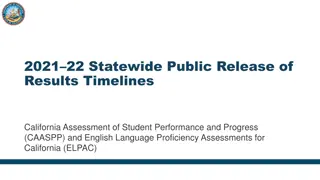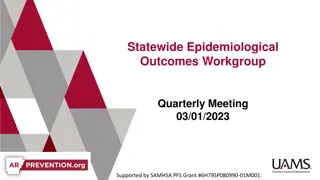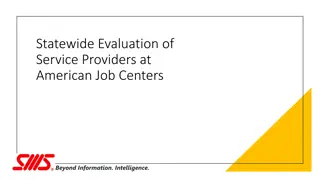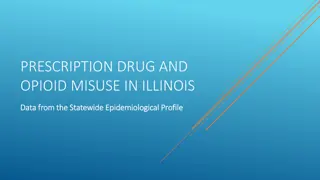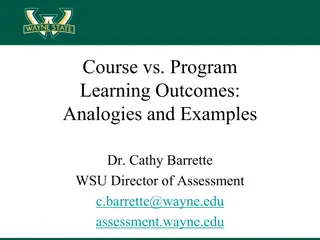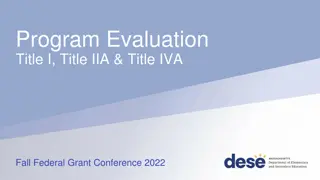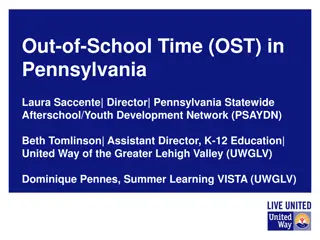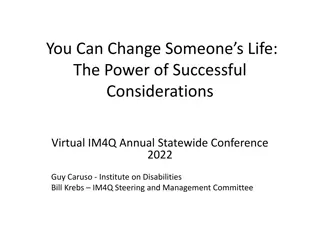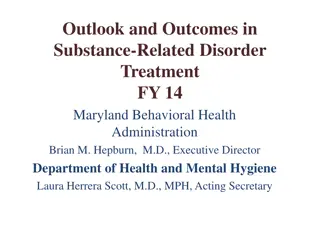Is It Working? Tracking Outcomes of PD Title I & Title IIA Statewide Conference
Overview of professional development outcomes tracking at a statewide conference, focusing on PD cycle approaches, assessment instruments, data analysis, and the importance of measuring effectiveness and impact.
Uploaded on Feb 20, 2025 | 1 Views
Download Presentation

Please find below an Image/Link to download the presentation.
The content on the website is provided AS IS for your information and personal use only. It may not be sold, licensed, or shared on other websites without obtaining consent from the author.If you encounter any issues during the download, it is possible that the publisher has removed the file from their server.
You are allowed to download the files provided on this website for personal or commercial use, subject to the condition that they are used lawfully. All files are the property of their respective owners.
The content on the website is provided AS IS for your information and personal use only. It may not be sold, licensed, or shared on other websites without obtaining consent from the author.
E N D
Presentation Transcript
Is it working? Tracking outcomes of Professional Development Title I & Title IIA Statewide Conference June 3, 2016
Agenda Overview of PD cycle Approaches to measuring outcomes Leicester Public Schools Cohasset Public Schools Questions 2
Context Nationally, measures of PD quality are not reassuring There are useful practices in MA and elsewhere Upcoming TIIA workbook: Standard 4: High-quality PD is assessed to ensure that it is meeting the targeted goals and objectives 3
PD Cycle After selecting PD initiatives Create/select the assesment instruments Analyze formative PD assessment data Collect and analyze final outcome data www.doe.mass.edu/pd/PlanAssess/ Title IIA can fund initiatives to determine the effectiveness of PD, as this is part of the Needs Assessment process 4
Who measures it? While some districts hire consultants, or have data anlysts track PD outcomes, others may want to increase their current staff s capacity. How do we measure it? May supplement quantitative data with qualititative data Keep in mind the data that informed the decision to fund this PD in the first place 5
Whats the metric? How some districts measure levels 4 & 5: 1. Participant reactions/satisfaction 2. Participants learning 3. Organizational change & support 4. Participants application of new skills 5. Student outcomes This doesn t tell us whether PD met its goals, but it s a start Look-fors Impact on achievement gaps for SPED & ELLs Pre- and post-assessments of students, purposefully aligned to PD Student work Evaluations pertinent to PD initiatives Changes showing up in observations End goal of the PD 6 It s not about proving 100% causality Adapted from Guskey, T. Does it make a difference? Evaluating professional development.
Purposeful Professional Development Leicester Public Schools
Getting started We have a Professional Development Committee made up of central office staff, administrators, and teachers that meet on a regular basis to discuss district PD The PD Committee began by looking at the Massachusetts Standards for High Quality Professional Development Using sticky notes, members of the committee were asked prioritize the High Quality Indicators A sideways bar graph showed immediate trends in 4 areas (2, 5, 6 & 10) The consensus for these areas shaped our district s HQPD Focus Goals 8
We have our Focus Goals...now what? Our next step was determining how to use PD to best meet the needs of our schools Lesson Study in of our buildings Learning Walks in all 4 buildings with a district focus of inquiry: Students articulate their thinking and reasoning using multiple means of expression Differentiation in the area of Mathematics through Looney Consulting in of our buildings 9
Feedback We provided our staff with Professional Development Feedback Sheets that directly correlated with HQPD indicators. Feedback from all schools was reviewed at Professional Development Committee Meetings. Learning Walk findings and trends were communicated with staff in 1- 2 days. 10
Next Steps Increasing Two Way Communication Root Cause Analysis Fish Bone Activity Progress Monitoring Matrix Completing these analysis activities with our Teacher Leaders, who will in turn bring the information to their grade level teams for feedback 11
Progress Monitoring Model/Graph Action Step Progress Indicator Benchmark/ Progress Monitoring Data Results Questions Next Steps 13
COHASSET PUBLIC SCHOOL DISTRICT TITLE IIA ASSESSMENT OF PROFESSIONAL DEVELOPMENT 14
ASSESSMENT OF PROFESSIONAL DEVELOPMENT Enduring Understandings: All participants are part of the decision and planning of the Professional Development The initiative fits into the district global needs and other initiatives (Strategic Plan) All Professional Development initiatives are periodically reviewed and repeated if needed All Professional Development must either have a resulting product or data evaluation 15
INITIAL STEPS: Survey, email, etc. of staff and/or have committees identify major professional development needs Initiatives selected address district goals Educators who are involved in the Professional Development are aware and in agreement: it is strongly supported or initiated by educators ESSENTIAL QUESTION THAT DRIVES PD: How do we know that the Professional Development plan includes all stakeholders input, impacts teaching and learning, is measurable, and is sustainable? 16
PD Initiatives Wilson Reading Technology Positive Behavior Intervention Support I AM (PBIS: FISH) 17
Questions? 18
Parting words Keep in mind, too, that good evidence is not that hard to come by if you know what you're looking for before you begin. If you do a good job of clarifying your goals up front, most evaluation issues pretty much fall into line. The reason many educators think evaluation at Levels 4 and 5 is so difficult, expensive, and time-consuming, is because they are coming in after the fact to search for results. It is as if they are saying, We don't know what we are doing or why we are doing it, but let's find out if anything happened. If you don t know where you are going, it s very difficult to tell if you ve arrived. -Guskey, T. Does it make a difference? Evaluating professional development. ASCD 59(6) March 2002 p. 45-51 19
Parting words There is no question that evaluating the impact of professional development is more complex than evaluating the effectiveness of a new drug or medical treatment. There are more intervening steps But hard is not impossible. The payoff will come not only in increased teacher productivity and satisfaction, but also, and more importantly, in increased student learning and growth. Noyce, P. Sept. 12, 2006. Professional Development: How Do We Know if it Works? Education Week. 26 (3) pp. 36-37. 20
Thank you! TitleIIAGrants@doe.mass.edu 21




